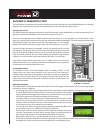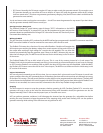
AUTOMATIC GENERATOR START
The combination of generator and inverter is common in remote or off-grid sites. Since OutBack inverters can recharge
batteries with a generator, the inverter can automatically start the generator and do it for you.
Starting Requirements
This feature requires a generator with electric start and automatic choke. Additionally, you need to determine if your
generator controls are classified as “two-wire-start” or “three-wire-start.”
A two-wire-start generator has a simple on-off switch. If the switch is on, the generator runs. If the switch is off, it
stops. All cranking, timing and other functions are automated within the generator. This is the simplest arrangement,
and OutBack products can easily control this kind of generator. You can usually
identify one because it has only a single switch with two positions: “on” and “off.”
A three-wire-start generator has separate controls for starting, and for running
and stopping. This requires three or more control wires. Because timers and other
devices are required, OutBack products can only control this generator with the
help of external products. You can usually identify one because it has multiple
switches, or it has one switch with three positions, like “start”, “run” and “stop.”
If you have a three-wire-start generator, you can adapt it into a two-wire-start.
Atkinson Electronics is one company that makes these adapters. You can get more
information at www.atkinsonelectronics.com.
FX AUXILIARY OUTPUT
The OutBack FX Series of inverter/chargers have an auxiliary (“AUX”) 12-volt
output which can drive various devices. In this case the AUX can directly or
indirectly send commands to the generator. Generally you need an intermediate
relay. Thus, the AUX would send a 12-volt signal to the coil of the relay. Then the
relay contacts would close, making the connection on the two-wire circuit and
starting the generator.
STARTING FUNCTIONS
The OutBack MATE’s Automatic Generator Start (“AGS”) feature will trigger the AUX output. AGS can control a generator
according to various conditions:
• LowVoltageStart.AGScanbeprogrammedforauto-startbasedonthreedifferentlowvoltages(user-settable)
for three different periods of time: 24 hours, 2 hours and 2 minutes. This feature
will put the batteries through a full charge cycle. At the end of the cycle, the AGS
will shut the generator off instead of entering the Float stage.
• LoadStart.AGScanstartthegeneratorifloadsexceedanamountforacertain
time. It will stop if the loads go below a certain amount for a certain time (all
settable). Note: this feature is meant to rescue the batteries from heavy draw. It
is not meant to rescue the inverter from an overload.
• TimeofDayStart.AGScanstartandstopthegeneratordailyatspeciedtimes.
It can also be set to run on a different schedule on weekends.
• ExerciseStart.AGScanrunthegeneratorforbriefperiods,tokeepitfrombeing
inactive. The generator can start after a number of days, at a particular time of
day, and run for a number of minutes (all settable) before shutting off.
• ManualStart.AGSwillrunorstopthegeneratorbymanualcommand.
• QuietTime.AGScanbeorderednottostartthegeneratorduringcertainhours(particularlywhenyourneighbors
are sleeping!). Certain criteria can override quiet time, for an emergency start.
AC Wiring Compartment Board
with AUX +/- Terminals




